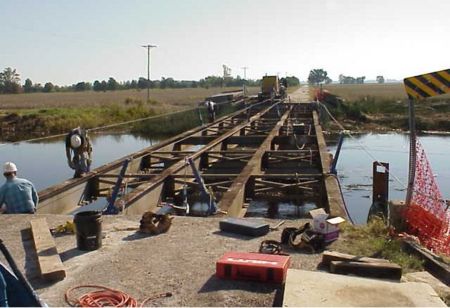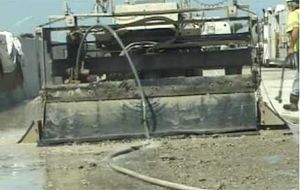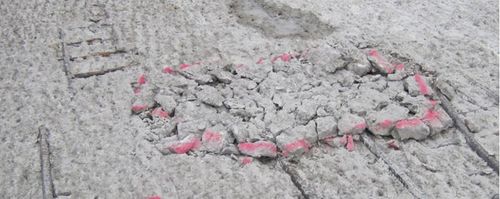Category:216 Removals for Bridge Structures: Difference between revisions
Per BR, deck rehabilitation guidance has been updated to current methods. Pay items updated for monolithic deck repair to supplementary wearing surface material. Rehabilitation design guidance was expanded |
|||
| Line 226: | Line 226: | ||
::All previous conventional deck repairs, regardless of condition, need removed prior to hydro demolition for the following reasons. | ::All previous conventional deck repairs, regardless of condition, need removed prior to hydro demolition for the following reasons. | ||
:::- The majority of previous conventional deck repair that appear to be sound prior hydro demolition becomes unsound during hydro demolition needing removal after hydro demolition. | :::- The majority of previous conventional deck repair that appear to be sound prior hydro demolition becomes unsound during hydro demolition needing removal after hydro demolition. | ||
[[image:216 removed.jpg|right|500px]] | |||
:::- Previous sound conventional deck repair protrudes into the new wearing surface creating a weaker area of the wearing surface. | :::- Previous sound conventional deck repair protrudes into the new wearing surface creating a weaker area of the wearing surface. | ||
:::- Conventional deck repair is inferior to a hydro demolition due to the creation of microcracks into the deck at the interface of the patch and the existing deck. Removing previous conventional deck repairs even in good condition is akin to removing a bandage in order to better clean the area and replace with a better performing bandage. | :::- Conventional deck repair is inferior to a hydro demolition due to the creation of microcracks into the deck at the interface of the patch and the existing deck. Removing previous conventional deck repairs even in good condition is akin to removing a bandage in order to better clean the area and replace with a better performing bandage. | ||
Latest revision as of 11:48, 4 February 2020
216.1 Construction Inspection Guidance for Sec 216

Removal of Bridges (Sec 216.10)
Description
As specified.
Removal Requirements
As specified.
Method of Measurement
As specified.
Basis of Payment
As specified.
Scarification of Bridge Deck (Sec 216.20)
Description
As specified.
Removal Requirements
As specified.
Method of Measurement
As specified.
Basis of Payment
As specified.
Seal Coat and Wearing Surface Removal (Sec 216.30)
Description
As specified.
Removal Requirements
As specified.
In order to determine the accepted quantities of the new wearing surface, it is important to obtain accurate measurements to determine the following:
- Average depth of existing wearing surface
- Average depth of scarification
- Average depth of additional deck removed with the removal of the wearing surface
Existing wearing surface in excess of plan thickness will require additional new wearing surface material without an acceptable adjustment to grade. The volume of this additional material should not need to be excluded from the accepted quantities of the new wearing surface.
Scarification in excess of the plan thickness and additional deck removed with the removal of the wearing surface in excess of the plan thickness will both require additional new wearing surface material. An adjustment to grade will not be acceptable in these situations and the volume of the additional material will need to be excluded from the accepted quantities of the new wearing surface.
Method of Measurement
As specified.
Basis of Payment
As specified.
Removal and Storage of Existing Bridge Rail (Sec 216.40)
Description
As specified.
Storage Requirements
As specified.
Method of Measurement
As specified.
Basis of Payment
As specified.
Removal of Existing Bridge Deck (Sec 216.50)
Description
As specified.
Removal Requirements
As specified.
Method of Measurement
As specified.
Basis of Payment
As specified.
Partial Removal of Existing Bridge Deck (Sec 216.60)
Description
As specified.
Removal Requirements
As specified.
Method of Measurement
As specified.
Basis of Payment
As specified.
Partial Removal of Culvert and Substructure Concrete (Sec 216.70)
Description
As specified.
Material
As specified.
Removal Requirements
As specified.
Method of Measurement
As specified.
Basis of Payment
As specified.
Curb Removal (Sec 216.80)
Description
As specified.
Material
As specified.
Removal Requirements
As specified
Method of Measurement
As specified.
Basis of Payment
As specified.
Removal of Existing Expansion Joint and Adjacent Concrete (Sec 216.90)
Description
As specified.
Material
As specified.
Removal Requirements
As specified.
Method of Measurement
As specified.
Basis of Payment

As specified.
Removal of Existing Expansion Joint Seal or Sealant (Sec 216.100)
Description
As specified.
Material
As specified.
Removal Requirements
As specified.
Method of Measurement
As specified.
Basis of Payment
As specified.

Total Surface Hydro Demolition (Sec 216.110)
Description
As specified.
Material
As specified.
Removal and Repair Prior to Hydro Demolition
As specified.
- 1. Removal of Existing Deck Repair (if specified in the contract)
- One of the issues with detecting and removing sound and unsound previous conventional deck repairs, is that sometimes the repairs themselves can be hard to distinguish from the deck itself. After milling the deck is quite dirty and everything blends together. The specified water blasting is very important to get the deck adequately cleaned so the inspectors can see everything.
- All previous conventional deck repairs, regardless of condition, need removed prior to hydro demolition for the following reasons.
- - The majority of previous conventional deck repair that appear to be sound prior hydro demolition becomes unsound during hydro demolition needing removal after hydro demolition.

- - Previous sound conventional deck repair protrudes into the new wearing surface creating a weaker area of the wearing surface.
- - Conventional deck repair is inferior to a hydro demolition due to the creation of microcracks into the deck at the interface of the patch and the existing deck. Removing previous conventional deck repairs even in good condition is akin to removing a bandage in order to better clean the area and replace with a better performing bandage.
- If unable to discern patches from original deck, refer to the district office for assistance with Division of Construction and Materials.
- 2. Zoned Conventional Deck Repair (if specified in the contract)
- As specified.
Total Surface Hydro Demolition
As specified.
In order to determine the accepted quantities of the new wearing surface, it is important to obtain accurate measurements to determine the average depth of hydro demolition in areas of sound concrete.

Hydro demolition (in areas of sound concrete) in excess of the plan thickness will require additional new wearing surface material. An adjustment to grade will not be acceptable and the volume of the additional material will need to be excluded from the accepted quantities of the new wearing surface.
Method of Measurement
As specified.
Basis of Payment
As specified.